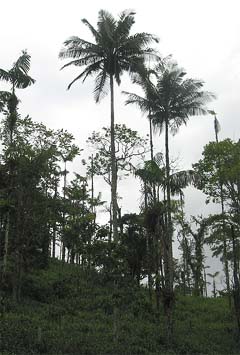Ceroxylon amazonicum Information
Identification:
Canopy palm. Stem solitary, 8 to 20 m tall, 12-25 cm in diameter, grey to white, internodes covered with thin layer of wax. Leaves 14–22, in dense, hemispheric crown, to 5 m long; rachis 203-290 cm long, twisted 90° on distal portion thereby holding the pinnae in a vertical position, adaxially flattened in about half of its length and ending in a well-defined 2 mm hastula-like projection, glabrescent with remnants of scales near the margins, abaxially convex, covered with oblong, adpressed, white, membranaceous scales; pinnae ca. 83-106 on each side, regularly arranged in one plane, horizontal, with the terminal part descending, the central ones 50-83 cm long and 4-5 cm wide, below with a thick, white to light brown, waxy indument, sometimes the apical pinnae united along the margins. Inflorescences arching to pendulous, to 3 m long, branched 3 times. Fruits globose, orange-red when ripe, 1.7-2.0 cm diam., exocarp smooth. Seeds 1.3-1.5 cm diam. C. amazonicum is diagnosed by its dense crown and leaves with regularly inserted and horizontal pinnae, staminate flowers with 9-12(-13) stamens, and smooth fruits. It is also the species that grows at lowest elevation.
General Information:
This Wax palm grows at the lowest elevation of all the Wax palms, and is therefore the least cold-hardy of them all. However, it is also one of the rarest and difficult to get. It is Endemic to SE Ecuador in premontane to tropical rain forest on clayey soils, at 820-1200 m elevation (most common around 1000 m.), where it is found growing with other mid-elevation palms such as Iriartea deltoidea, Wettinia maynensis and Oenocarpus bataua. Nevertheless, Ceroxylon amazonicum can tolerate mild frost.
Distribution:
Native to, Ecuador
Southeastern Ecuador, on eastern slopes of the Andes; premontane or lower montane rain forest, at 820-1200 m elevation.
Location: Ecuador (-3.923444°N, -78.662109°E)

